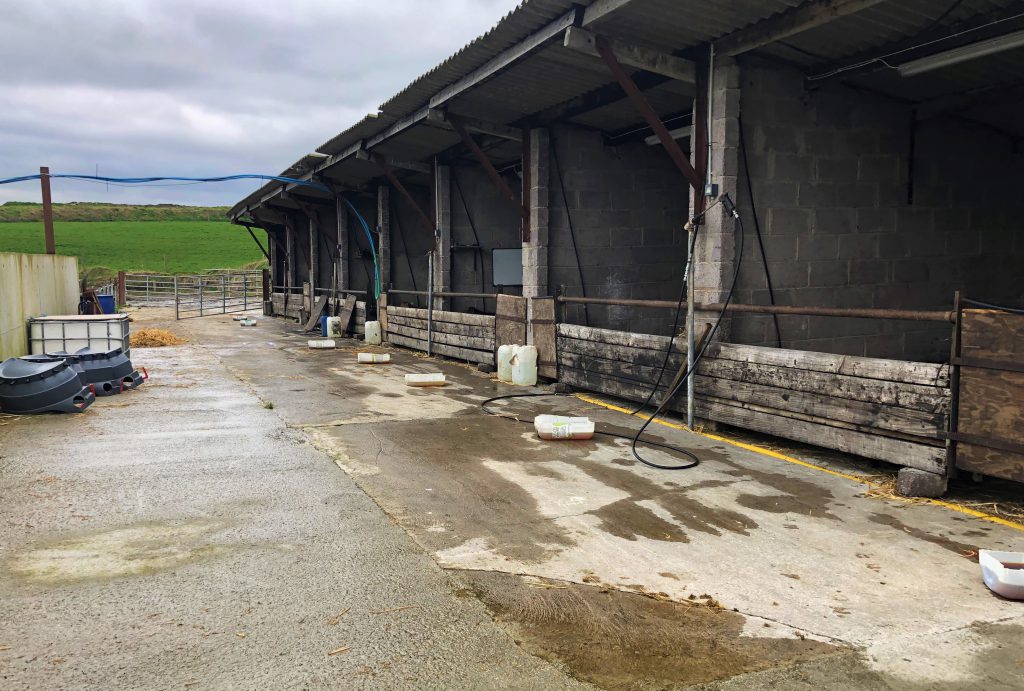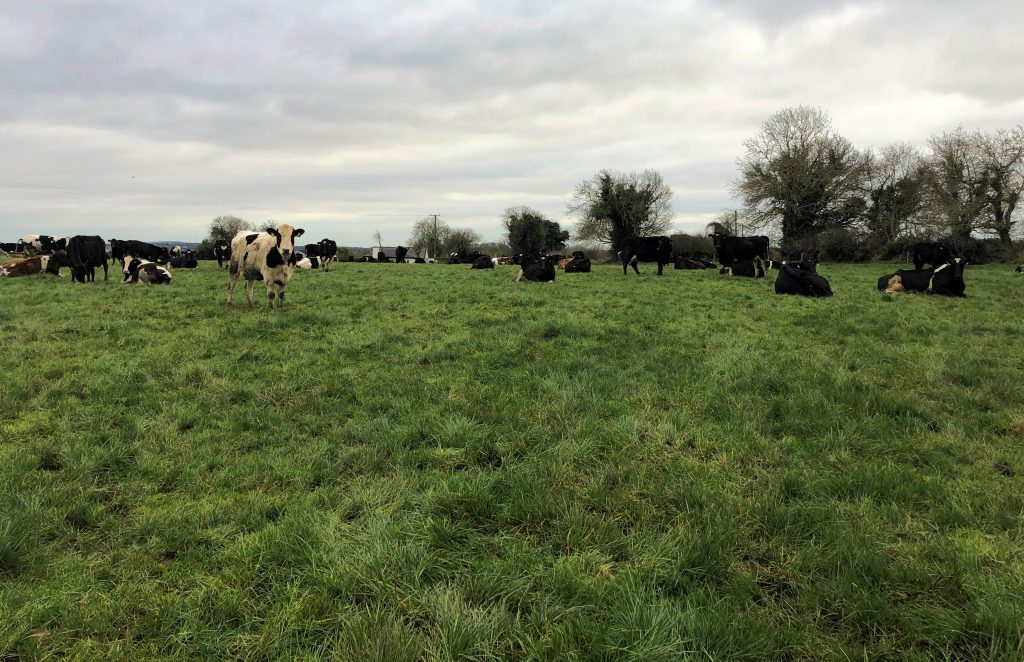Dairy farming a stone’s throw away from Stamullen village, Joe Leonard is progressing nicely through the calving season with just over 200 cows calved out of a sizable 650 cows due to calve this year.
Calving was due to start on January 31, but the first calf unexpectedly arrived on January 20. The aim is to have 50% of the herd calved by February 23.
While 650 cows are expected to calve, Joe explained that he is hoping to milk between 620 and 630 cows this year.
The total farm stretches over 255ha, including 175ha of a milking platform – with outside blocks used for silage and rearing youngstock. Once calving has finished, the milking platform will be stocked at approximately 3.5LU/ha.
On average, between 14t DM/ha and 15t DM/ha is grown on the farm annually; but last year 12.5t DM/ha was recorded. However, Joe feels this figure is inaccurate due to a number of changes in the grass-measuring protocol during the year.
On the day of the visit, the cows were surprisingly out grazing and had been full-time out grazing – by day and by night – up until last Saturday; but on-off grazing was being used since – to deal with the poor weather conditions.
The cows were also on once-a-day (OAD) milking; although Joe plans on switching them back over to twice-a-day (TAD) milking next week.
Last year, the herd delivered 440kg of MS/cow on about 550kg of meal/cow; but, Joe said his discussion group feels he should be aiming for 470-480kg of MS/cow.
“I’ve come from so many years of producing the milk as cheap as I can and I am only slowly coming round to feeding a little bit more meal and trying to find where the happy medium is,” Joe commented.
What was most striking about Joe’s farm was the high level of team work and organisation involved in calving down a large number of cows in such a short space of time.
The team
The team plays a critical part in the efficient and successful running of the calving season on the farm.
Currently, this team consists of six people – with each person having their own responsibility for the spring period.
“They all have their assigned roles, but they will help each other out when they are needed.
A good thing about everyone having assigned roles is, if you have the same person looking every day, you can be more consistent in what is going on.
“If everyone working in the parlour, or with the calves, keeps chopping and changing you can lose the consistency,” explained Joe.
- Joe – fills in when anyone is off, management and maintenance;
- Matt (Joe’s brother) – in charge of feeding and checking the stock;
- John (full-time employee) – runs the milking parlour and grass measures;
- Rob (full-time employee) – night time calver for six-weeks;
- Andrew (diploma in dairy farm management student) – head calf rearer;
- Ciaran (Ballyhaise student) – helps Andrew with calf rearing and anyone else who might need help.
Commenting on the management of the team, he said: “I try to be fair with the hours and make sure everyone gets time off.
They all have dedicated roles and I try not to look over their shoulders too much; so they don’t feel like they are being micromanaged. They have a say in what is going on too, that’s important.
“The rotary helps with the workload as well – when the season gets going they only ever do five milkings in a week.”
Their day starts at 7:00am with everyone leaving the yard between 5:00pm and 5:30pm. Every one in four days, one person comes back at about 7:30pm to check on the cows. The night calver, Rob, begins at 9:00pm and finishes when everyone comes in the morning.
Calving
Every two days, all the cows are run through the drafting system and any cows which appear close to calving are moved into the ‘maternity ward’.
The maternity ward consists of a large open shed, capable of holding up to 120 cows, with a feeding area to the front.
Once a cow calves, she is separated out, milked and goes straight out to grass with the colostrum group. She stays in this group for five days before joining the main herd.
The calf has his/her naval dipped, is tagged and stomach tubed 3L of colostrum before being placed in a group pen.
The farm has quite a unique method of heating the colostrum. The colostrum is run through an old water heater, to heat it to an adequate temperature before being fed.
After they are given their colostrum, the heifers and bulls are separated into different sheds at opposite ends of the yard. The heifers are bedded with straw and the bulls are bedded with peat.
Asking Andrew, the head calf rearer, about the peat bedding, he said: “It is a good bedding as it has a low pH, which kills bacteria. Once the calves are taken out of a pen I just give it a rake up and it is ready to go again.
“The only issue is the calves don’t get that nesting effect like they do with straw, but we have tried to block any draughts as much as possible.”
Thereafter, the heifers are moved straight onto milk replacer. A milk replacer – consisting of 25% fat and 22% protein – is fed TAD, at a rate of 600g/calf/day in 6L – for 10 days. The bulls are fed transition milk OAD at a rate of 6L/calf/day.
“Last year was the first year we used milk replacer; before everything was fed transition milk. As we have become more conscious of the Johne’s disease issue, we started using milk replacer on the heifers,” explained Joe.
After 10 days, the heifers are moved onto OAD. At this point, they are then moved into a bigger group pen capable of holding up to 80 calves – where they are fed using a homemade milk trolley.
“From day one, they are also offered meal, straw and fresh water. This year we switched over the small meal pellets because the crows go mad for the calf crunch,” highlighted Joe.
All the calf sheds are well set up for the efficient feeding of calves and so that they can be comfortably cleaned out when needed.
Milk or milk replacer can be easily pumped – from the parlour – over to both the heifer shed and the bull shed for feeding.
Each shed also has a power washer on hand and after a pen is emptied it is cleaned out, power washed and disinfected. Footbaths are located outside each pen as a method of disease prevention.
Spring grazing
Aforementioned, on-off grazing was being used for the past four to five days to maintain grass in the diet. As soon as the ground conditions improve they will be back to grazing full-time.
“The cows leave the yard with an appetite after milking and return in at about 4:00pm – or earlier if the weather turns wet.
“When they are out grazing full-time, they are not getting any silage. Now we have them on 3kg of meal, 5-6kg of grass and about 3kg of 75% dry-matter digestibility (DMD) silage, each.
“I am conscious of making sure there is a gut fill there, particularly when the weather is messy, to make sure we are not getting any left-displaced abomasums (LDAs) or anything like that. Minerals are fed through the meal,” explained Joe.
Finally touching on their grazing targets for the spring period, he said: “Our aim is to have 35-40% grazed by the end of February; we will see where we get to. At the moment, if we have 10% grazed we are doing well.
“Numbers will build up fairly rapidly and we won’t be far off that target. Our opening cover was 830kg DM/ha and we grew between 3kg DM/ha and 4kg DM/ha over the winter period.
“Slurry was put out on half the paddocks and all the paddocks got 23 units/ha of urea in the second half of January and covers have certainly picked up.”









